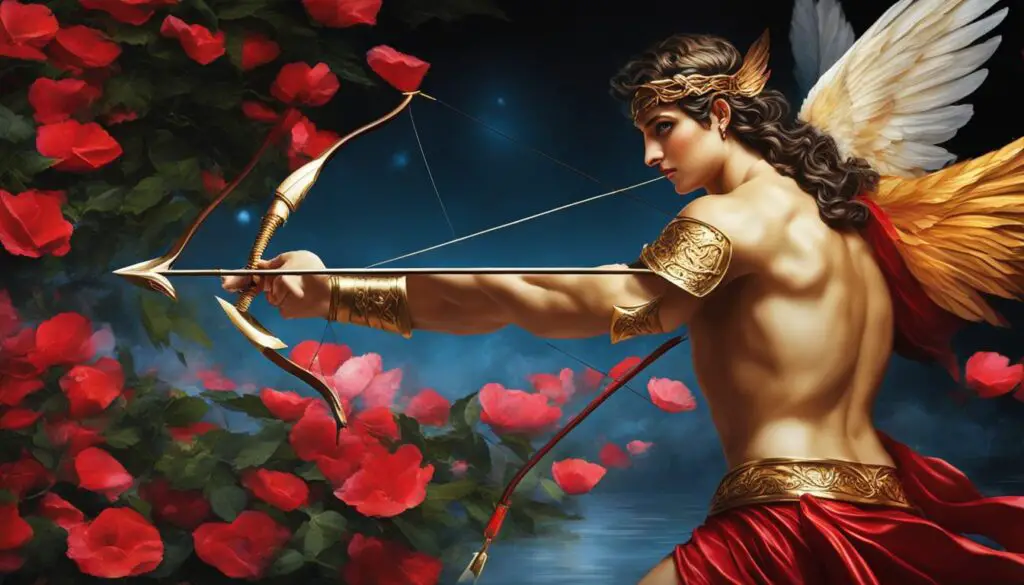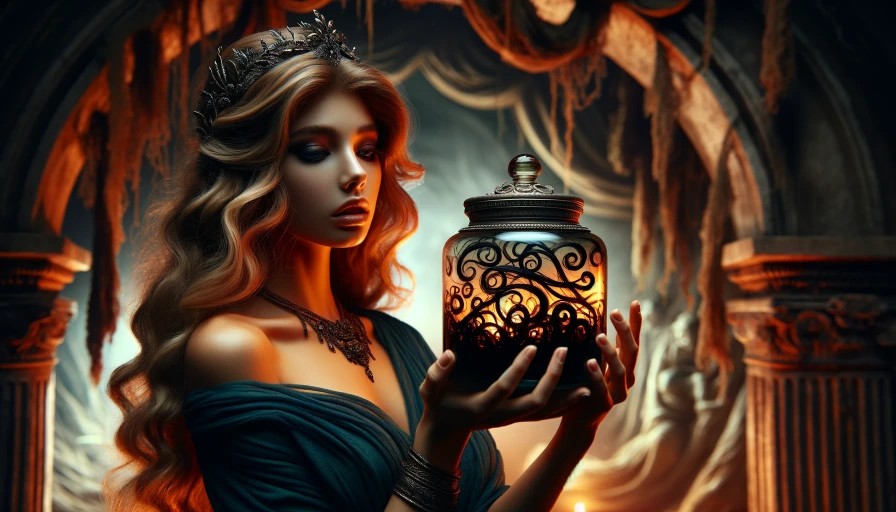Welcome to our exploration of the fascinating world of Greek mythology! Today, we delve into the realm of Eros, the Greek god of love and beauty. Eros, often associated with passion and desire, holds a significant place in Greek mythology. As the son of Aphrodite and Ares, he stands as a deity of lust and infatuation, possessing a range of incredible powers and abilities.
In this article, we will take a closer look at the powers and abilities that Eros wields, as well as his role in Greek mythology, art, philosophy, and even modern interpretations. From his influence over emotions to his iconic weapons, we will uncover the captivating essence of Eros and his enduring impact on our understanding of love and desire.
Key Takeaways:
- Eros is the Greek god of love and beauty, known for his association with passion and desire.
- He possesses various powers and abilities that give him control over emotions and the ability to inspire love.
- Eros’ appearance, symbolizing beauty and allure, captures the enchanting nature of love and desire.
- His iconic weapons, including his golden bow and arrows, allow him to enforce his power over love.
- Eros plays a significant role in Greek mythology, art, philosophy, and modern interpretations, captivating audiences across centuries.
Eros in Greek Mythology
In Greek mythology, Eros is a prominent figure known as the god of love, desire, and sexual attraction. Often depicted as a youthful and beautiful winged figure armed with a bow and arrows, Eros played a significant role in inspiring love and bringing about romantic relationships among both gods and humans. His powers and abilities allowed him to control emotions and ignite intense feelings of passion and infatuation.
As the son of Aphrodite and Ares, Eros possessed a divine authority over love and desire. His arrows, crafted with the purpose of romance, had the ability to strike any individual and spark uncontrollable feelings of attraction and love towards another. These arrows could even make individuals confess their true romantic feelings and discern if someone was lying about their emotions.
In Greek mythology and art, Eros’ captivating appearance symbolized the enchanting and irresistible nature of love and desire. With his golden wings, he embodied the concept of beauty and attraction. Eros’ influence extended beyond ancient Greek mythology and philosophy, making him a beloved and enduring figure in literature, art, and popular culture even today.
Description of Eros
Eros, the Greek god of love and desire, is characterized by his captivating appearance and powerful symbolism. He is often portrayed as a youthful and handsome deity, with blond hair, blue eyes, and an enchanting smile. Eros’ physical beauty reflects the irresistible nature of love and desire, captivating both gods and mortals alike.
To further emphasize his divine nature, Eros is typically depicted with large golden angelic wings, symbolizing his ability to soar above and transcend earthly boundaries. These wings also represent the ethereal and transformative nature of love, which can lift individuals to new heights of passion and enchantment.
In some artistic representations, Eros takes the form of a cherub, a small and innocent-looking figure. This portrayal emphasizes the purity and innocence often associated with love, highlighting Eros’ role in inspiring romantic connections and deep emotional bonds.
Powers of Eros

As the Greek god of love and desire, Eros possesses a range of powers and abilities that make him a formidable deity. His divine authority allows him to have control over emotions, particularly those related to love, lust, and desire. With a mere glance or touch, Eros can induce feelings of intense attraction and infatuation in anyone, be it gods, mortals, or even animals.
One of Eros’ most well-known powers is his ability to shoot arrows of romance. These enchanted arrows have the power to make anyone struck by them feel an uncontrollable desire and love for another person. This power has been the source of many mythical love stories, with individuals falling deeply in love against their will, all thanks to Eros’ magical arrows.
Eros’ Powers and Abilities:
- Causing lust and infatuation in individuals
- Divine authority over love, lust, and desire
- Shooting arrows of romance to induce feelings of love
Additionally, Eros possesses other extraordinary abilities. He has the power to force individuals to confess their true romantic feelings, making it impossible for anyone to hide their love or deceive others. Eros is also capable of detecting lies when it comes to matters of the heart. His wisdom and intuition in matters of love are unparalleled.
Beyond his control over emotions, Eros has the power to manipulate his appearance and render himself invisible. He can change his physical form based on what is perceived as beautiful, making him an alluring and enchanting figure. Furthermore, Eros can teleport, manipulate time, and even create portals, allowing him to traverse different realms and bring love to all corners of the universe.
Eros’ Abilities:
- Forcing individuals to confess their true feelings
- Ability to detect lies related to love
- Manipulating appearance and rendering himself invisible
- Teleportation, time manipulation, and portal creation
Eros’ powers and abilities make him a mighty force in Greek mythology. Through his actions, he brings about love, passion, and desire, shaping the relationships between gods and mortals alike. His enchanting presence continues to inspire artists, writers, and storytellers, ensuring that the power of Eros remains relevant and captivating even in modern times.
Eros’ Abilities and Powers in Greek Mythology
Eros, the Greek god of love and desire, possesses a myriad of abilities and powers that make him a formidable force in both the divine and mortal realms. Let’s explore some of the remarkable powers that Eros wields:
Precise Mastery of Emotions
- Ability to Force True Confessions: Eros has the remarkable power to compel individuals to reveal their deepest romantic feelings, making him an unerring judge of love and desire.
- Sense of Deception: With an unparalleled ability to detect lies, Eros can always tell when someone is being dishonest about their emotions, ensuring the authenticity of love.
Shapeshifting and Invisibility
- Beauty and Allure: Eros possesses the gift of aesthetic transformation, allowing him to change his appearance to match the perception of beauty held by the beholder, making him irresistible to all.
- Invisibility: Eros can render himself completely invisible, effortlessly moving through the world undetected, granting him the ability to observe and influence love without being seen.
Mastery of Time and Space
- Manipulation of Time: Eros holds the power to manipulate time itself, altering the course of events to create opportune moments for love and desire to flourish.
- Portal Creation: Eros can create portals to transport himself and others across vast distances, ensuring that love knows no bounds and can transcend any physical limitations.
With these incredible abilities at his disposal, Eros embodies the essence of love and desire, always working to bring passion and romance into the lives of both gods and mortals alike.
Eros’ Paraphernalia
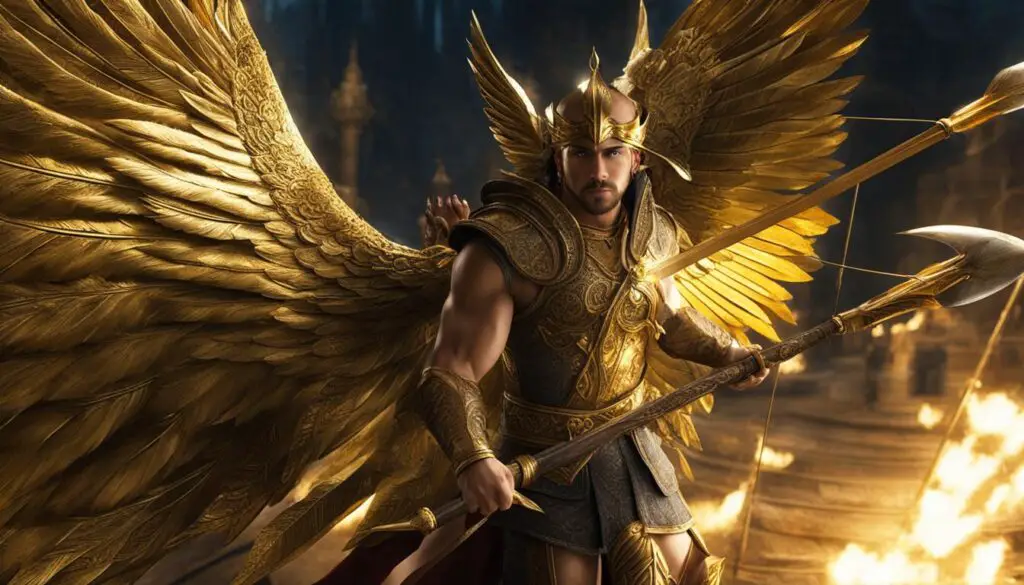
As the Greek god of love and desire, Eros is often depicted with his iconic paraphernalia that represents his power and influence. One of the most notable items is his romantic golden bow and arrows. These arrows are not ordinary projectiles but possess the ability to enforce Eros’ authority over love. When struck by one of these arrows, a person feels an intense desire and love for the target, unable to resist the overpowering emotions.
In addition to his bow and arrows, Eros also carries a quiver to hold his magical ammunition. This quiver is an essential part of his arsenal, allowing him to have a ready supply of love-inducing arrows at his disposal. With his quiver filled, Eros is always prepared to ignite passion and infatuation in the hearts of both gods and mortals.
Eros’ Paraphernalia:
- Golden Bow: The symbol of Eros’ divine power over love and desire.
- Arrows: Magical projectiles that cause uncontrollable attraction and infatuation.
- Quiver: A container used by Eros to hold his arrows, ensuring he is always armed and ready.
These items not only serve as symbols of Eros’ authority but also represent his ability to bring love and desire to the world. They have played a significant role in countless myths and stories where Eros intervenes to inspire romantic relationships and ignite the flames of passion between individuals.
Appearance of Eros
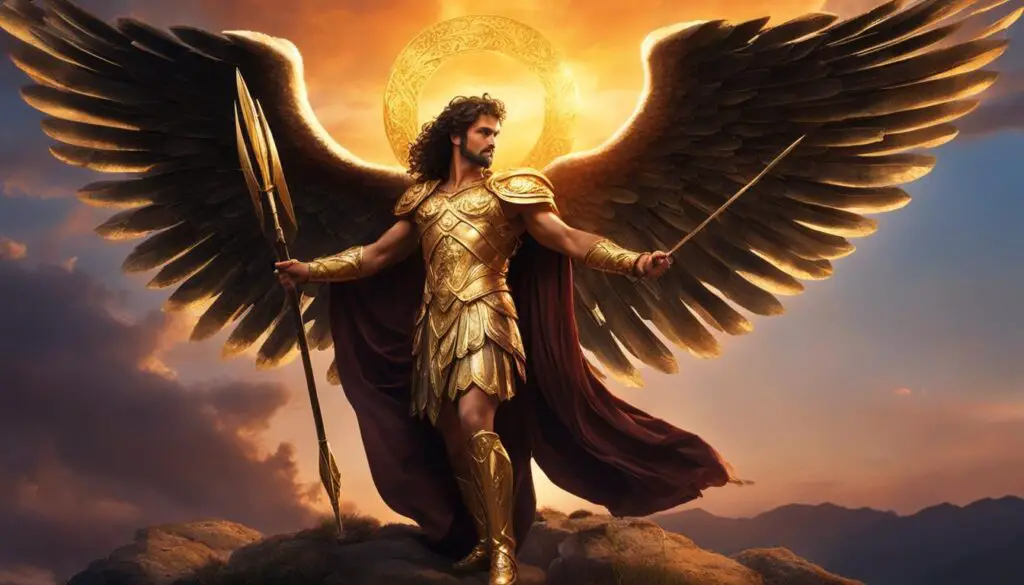
In Greek mythology, Eros is typically portrayed as a youthful and handsome figure adorned with golden wings. His physical appearance embodies the concept of beauty and attraction, captivating both gods and mortals alike. Artists often depict Eros in various poses and situations, depending on the specific myth or story being portrayed.
One can envision Eros with his golden hair cascading down his shoulders and his piercing blue eyes enchanting all who gaze upon him. The addition of large golden wings further emphasizes his heavenly nature, symbolizing his ability to transcend boundaries and bring love to all corners of the world. With his charming smile and graceful demeanor, Eros exudes an irresistible allure that embodies the essence of love and desire.
Eros in Art
Eros has had a profound influence on Greek art throughout history. From sculptures to paintings, his image is a recurring motif that symbolizes the power of love. Artists have skillfully captured the essence of Eros’ appearance, showcasing his youthful beauty and angelic presence. Whether depicted as a cherub or a winged figure armed with a bow and arrows, Eros serves as a visual representation of the transformative and all-encompassing nature of love.
Throughout the centuries, Eros has been paired with various figures in art, most notably alongside Psyche, representing the union of love and the soul. These artistic representations not only showcase the physical appearance of Eros but also explore the complexities and emotions associated with love and desire.
Significance of Eros’ Appearance
- The youthful and handsome appearance of Eros symbolizes the eternal nature of love and desire.
- The golden wings represent his ability to transcend boundaries and bring love to all beings.
- Eros’ physical beauty captures the attention and ignites the passion of gods and mortals alike.
- Artistic representations of Eros and his appearance serve as a reminder of the transformative power of love.
Eros in Mythology and Art
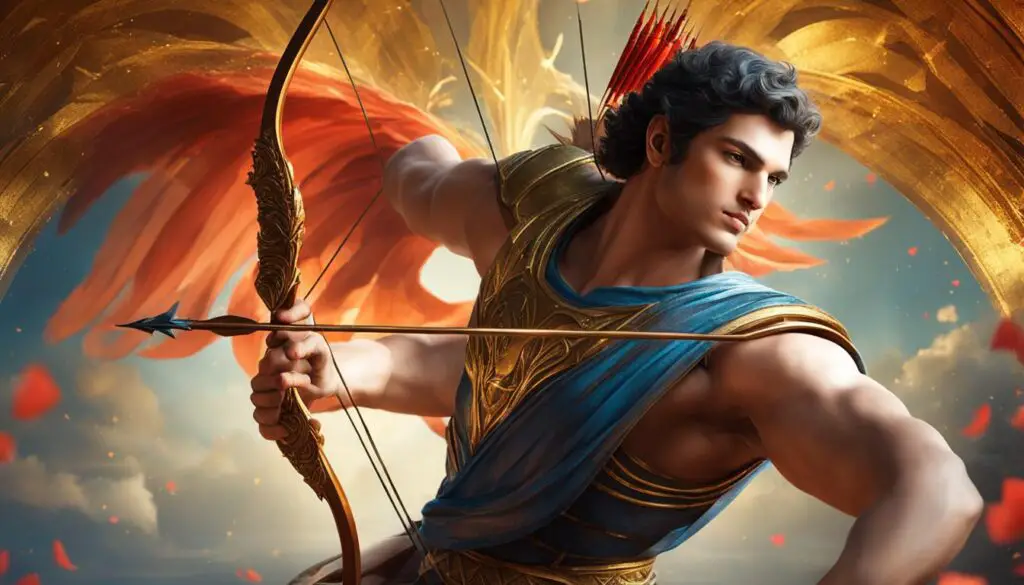
Eros, the Greek god of love and desire, plays a significant role in ancient Greek mythology. He is often depicted as a youthful and beautiful winged figure, armed with a bow and arrows. Eros’ primary role is to inspire and bring about romantic relationships, both among the gods themselves and between gods and mortals.
In Greek art, Eros is a popular subject, with many sculptures and paintings showcasing his divine presence. Artists often depict him in various poses, capturing the essence of love and desire that he represents. One famous representation of Eros is the sculpture known as “Eros Sleeping” by the artist Praxiteles, which portrays the god in a peaceful slumber.
Eros and Psyche
One of the most well-known stories involving Eros in Greek mythology is the tale of Eros and Psyche. Psyche, a mortal princess, becomes the object of Eros’ affection, and their love story embodies the eternal struggle between love and trust. This myth has inspired numerous artistic interpretations, including paintings by artists such as William-Adolphe Bouguereau and Antonio Canova.
Eros’ Influence in Western Art
Eros’ influence extends beyond ancient Greece and into Western art. Throughout history, artists have drawn inspiration from Greek mythology and incorporated Eros into their works. From Renaissance paintings to contemporary art, the figure of Eros continues to captivate audiences with his representation of love and passion.
Eros Cult: Worship and Devotion to the Greek God of Love
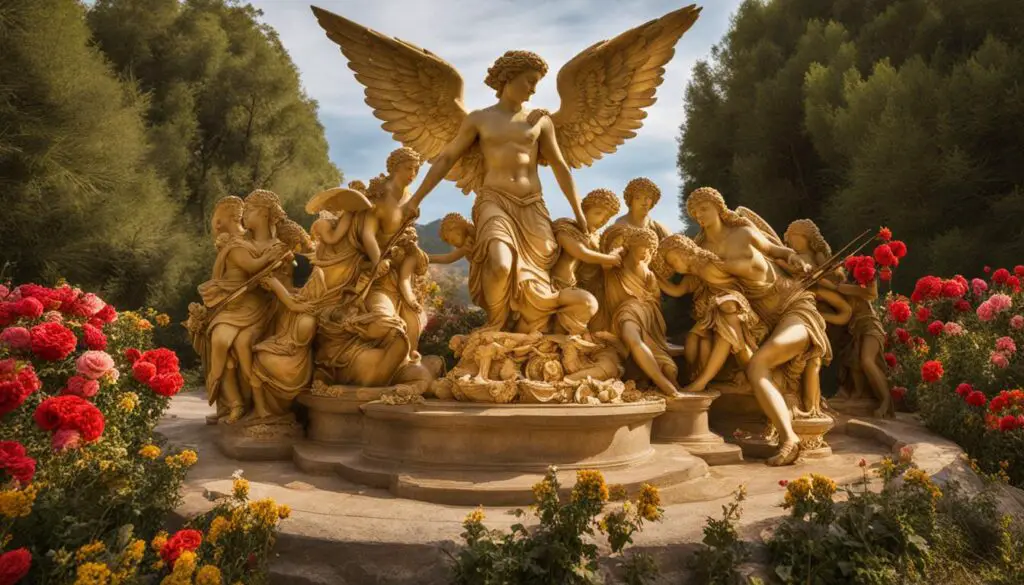
Eros, the Greek god of love and desire, had a devoted following in ancient Greece. His cult, centered primarily in Thespiae and Athens, involved specific festivals and rituals dedicated to the worship of Eros and his mother, Aphrodite. The cult of Eros was associated with fertility, desire, and love, and it held a significant place in the religious practices of the ancient Greeks.
The worship of Eros often occurred alongside Aphrodite, emphasizing the interconnectedness of love and desire. One of the most well-known festivals dedicated to Eros was the Adonia, a three-day celebration held in midsummer to honor the love and beauty associated with the deities. During this festival, devotees would engage in various rituals, including offerings, processions, and performances, to express their reverence for Eros and Aphrodite.
Key Aspects of Eros’ Cult:
- Reverence for Love: The cult of Eros placed a strong emphasis on the power and importance of love in human existence. Devotees believed that by worshiping and honoring Eros, they could invite love and desire into their lives, whether in romantic relationships or other areas of personal connections.
- Fertility and Procreation: Eros was often associated with fertility, and his cult was frequently sought after by individuals desiring children. Worshipers would offer prayers and make offerings to Eros, seeking his divine intervention in matters of conception and family expansion.
- Seeking Romantic Relationships: Those looking for love and seeking romantic relationships often turned to the cult of Eros for guidance and support. The rituals and festivals dedicated to Eros aimed to bring people together, fostering connections and encouraging the formation of new romantic partnerships.
The cult of Eros played a crucial role in promoting and celebrating the power of love and desire in ancient Greek society. It provided a spiritual outlet for individuals to express their devotion to Eros and seek his blessings for matters of the heart. Today, while the cult of Eros may no longer exist, his influence and symbolism continue to inspire and captivate individuals, reminding us of the enduring power and beauty of love.
Eros in Greek Philosophy
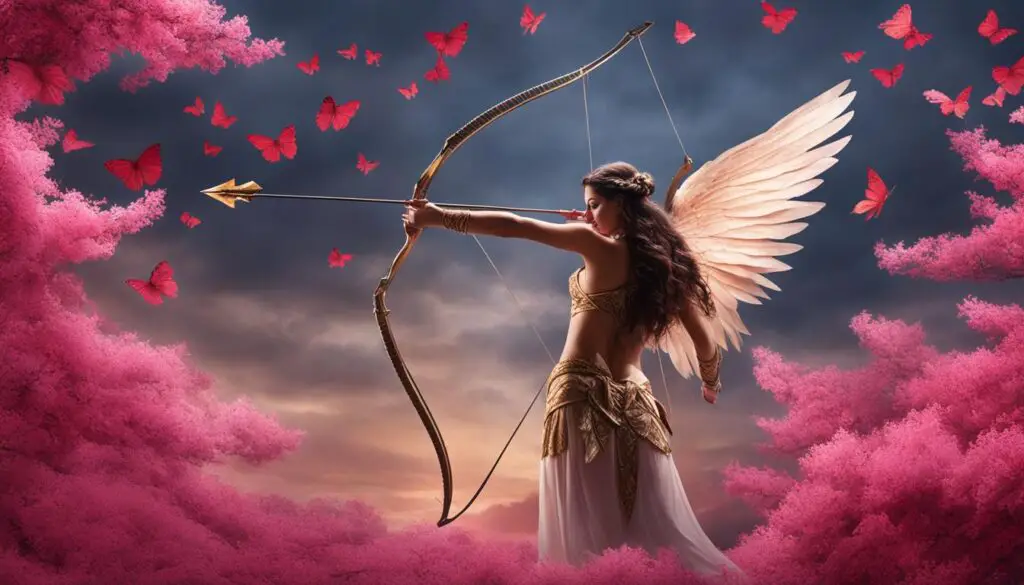
The influence of Eros extends beyond Greek mythology and art and finds itself deeply embedded in Greek philosophy. Philosophers, including Plato and other notable thinkers, have extensively discussed the nature of Eros and its significance in human existence.
Plato, in particular, explored the concept of Eros in his dialogues, emphasizing the connection between love and the pursuit of virtue and happiness. According to Plato, Eros is a powerful force that drives individuals to seek love and fulfillment of their desires. He believed that Eros represents the longing for beauty and the divine, acting as a catalyst for spiritual growth and enlightenment.
In Plato’s Symposium, he presents various perspectives on Eros through the speeches of different characters. Each speech offers a unique interpretation of Eros, highlighting its complexities and its role in human relationships and personal growth. Through these dialogues, Plato delves into the transformative power of love and its ability to elevate the soul.
The Concept of Eros in Greek Philosophy:
- Eros as a force that propels individuals towards the pursuit of virtue and happiness
- The connection between Eros and the longing for beauty and the divine
- The transformative power of love to elevate the soul and inspire personal growth
- The various interpretations of Eros in Plato’s Symposium
Overall, the exploration of Eros in Greek philosophy delves into the deep complexities and significance of love in human existence. The discussions and interpretations provided by philosophers shed light on the profound influence Eros has had on the pursuit of knowledge, wisdom, and personal fulfillment.
Eros in Modern Interpretations

Eros, the Greek god of love and desire, has continued to captivate and inspire people through various modern interpretations. His timeless influence extends beyond ancient Greek mythology and philosophy, making him a prominent figure in literature, art, and popular culture for centuries.
In literature, Eros is often portrayed as a mischievous yet powerful deity, whose arrows of love and desire can lead to both joy and heartache. Numerous authors have explored the themes of passion, romance, and the complexities of human relationships through their interpretations of Eros. From Shakespeare’s iconic love stories to modern romance novels, Eros has remained a symbol of intense emotion and the pursuit of love.
In art, Eros is frequently depicted in paintings, sculptures, and other visual mediums. Artists often draw on the classical representations of Eros as a winged figure, armed with a bow and arrows, to convey the idea of love’s transformative power. His presence in artworks serves to remind viewers of the universal nature of love and its impact on human lives.
Eros’ modern interpretations can also be found in popular culture, such as movies, music, and fashion. Hollywood has often drawn inspiration from Greek mythology, with Eros making appearances in various films and TV shows. His character is often portrayed as a matchmaker, bringing together unlikely couples or guiding protagonists on their journey to find true love.
- Music artists have also drawn upon Eros’ symbolism in their songs and performances. The themes of love, desire, and attraction are common motifs in popular music, and Eros’ name and image are often used to evoke these emotions.
- Fashion designers have incorporated Eros’ imagery into their collections, using his symbol of love and desire to create garments that convey sensuality and romanticism.
Eros’ modern interpretations continue to resonate with people of all ages and backgrounds, reminding us of the enduring power of love and the universal longing for connection. By exploring the many facets of Eros’ character and symbolism, contemporary interpretations of this Greek god help to keep the spirit of love alive in our modern world.
Conclusion
In conclusion, Eros, the Greek god of love and desire, possesses a multitude of powers and abilities that make him a central figure in Greek mythology and beyond. As the son of Aphrodite and Ares, Eros wields divine authority over love, lust, and desire. His arrows of romance can ignite intense feelings of passion and infatuation in anyone they strike, whether they be gods, mortals, or even animals.
Not only does Eros have the power to cause love, but he also has the ability to uncover the true romantic feelings of individuals and can discern when someone is lying about their emotions. His captivating beauty and allure allow him to change his appearance based on the perception of beauty, rendering him irresistible to those who encounter him.
Through his presence in Greek mythology and art, as well as his continued influence in literature, art, and popular culture, Eros remains a captivating and inspiring figure. His representation of love and passion continues to captivate the hearts and minds of people today, making him an enduring symbol of romance and desire.
FAQ
What powers does Eros have in Greek Mythology?
Eros, the Greek god of love and beauty, possesses various powers and abilities that allow him to control emotions and bring love to both gods and mortals. He has the power to cause lust and infatuation in individuals, whether they are gods, mortals, or animals. Eros can also force anyone to confess their true romantic feelings and always tell if someone is lying about their feelings.
Who is Eros in Greek Mythology?
Eros is the Greek god of love, desire, and sexual attraction. He is the son of Aphrodite and Ares, making him a deity of lust and infatuation. Eros played a significant role in bringing about romantic relationships and inspiring love in both gods and humans.
What is the appearance of Eros?
Eros is often depicted as a young and beautiful winged figure, armed with a bow and arrows. He is usually described as a young and handsome deity, with blond hair and blue eyes. Eros is typically portrayed as a youthful and handsome figure with golden wings. His physical appearance embodies the concept of beauty and attraction.
How is Eros depicted in Greek art?
Eros is a popular subject in Greek art, with many sculptures and paintings depicting his role as the god of love and desire. Artists often depict Eros in various poses and situations, depending on the specific myth or story being portrayed. He is commonly paired with other figures, such as Psyche, in artistic representations.
Did Eros have a cult following in ancient Greece?
Yes, Eros had a cult following in ancient Greece, particularly in Thespiae and Athens. He was often worshipped alongside Aphrodite, with specific festivals and rituals dedicated to them. Eros’ cult was associated with fertility, desire, and love, and was particularly revered by those seeking romantic relationships.
What was Eros’ role in Greek philosophy?
Eros was a popular subject of discussion in Greek philosophy, particularly in works by Plato and other philosophers. Plato explored the nature of love and its connection to the pursuit of virtue and happiness. Eros is often regarded as a powerful force that drives individuals to seek love and fulfill their desires.
How does Eros continue to influence modern interpretations?
Eros’ influence extends beyond ancient Greek mythology and philosophy. He has remained a popular figure in literature, art, and popular culture for centuries. His portrayal as a mischievous yet powerful deity continues to captivate and inspire people today.


